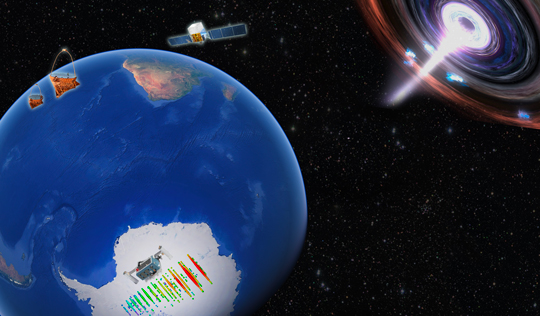 JOINT press release ASI, INAF, INFN
JOINT press release ASI, INAF, INFN
For the first time, we have been able to identify the possible source of a cosmic neutrino, thanks to its association with a gamma ray source. We are talking about a blazar, that is an active galaxy with a supermassive black hole at its centre, at a distance of 4.5 billion light-years, in the direction of the constellation of Orion. Researchers achieved this extraordinary result, published in Science, by combining the data from the IceCube neutrino detector, which operates among the glaciers of the South Pole, with 15 other experiments for detecting photons from Earth and in space. The INFN, the National Institute of Astrophysics (INAF), the Italian Space Agency (ASI) and various Italian Universities made decisive contributions by participating with their researchers in many of the experiments and observatories involved in the discovery. On 22 September 2017 the IceCube neutrino detector observed an interesting neutrino, then renamed IC-170922A. This was of interest, because its extremely high energy, equal to 290 TeV (teraelectronvolts, one thousand billion electronvolts), showed that, in all probability, it originated from a very “active” remote celestial object. Since, in theory, production of cosmic neutrinos is always accompanied by gamma rays, when IceCube observed IC-170922A, it immediately sent a “neutrino alert” to all telescopes, spread around in space and on earth, in the hope that their observations might help identify the source accurately. And that’s what happened: the Fermi satellite, designed by NASA with an important contribution from ASI, INAF and INFN, observed through its LAT telescope very high energy gamma-waves coming from the direction of the neutrino and found an emission coinciding with a source of gamma-rays in an “excited” state, the blazar TXS 0506+056, which is an active galaxy, expelling a jet of relativistic matter, particle and radiation energy flows at a speed close to that of light. Fermi-LAT immediately passed on the alert via an astronomical telegram, allowing all the other 14 experiments to aim at the source. The Italian AGILE satellite, made by ASI with the contribution of INAF and INFN, then confirmed the Fermi-LAT information with another Telegram. The MAGIC telescopes, desgined and run with a major contribution from INAF and INFN, on the island of La Palma in the Canaries, to study the gamma-rays from Earth through Cherenkov radiation produced by the interaction of gamma-photons from celestial sources with the earth’s atmosphere, also turned their gigantic mirrors towards the source and, after 12 hours of observation, managed to detect it, observing it at an energy one thousand times greater than that of Fermi and thereby supplying another important piece towards the completion of this discovery. Unlike the case of gravitational waves and the violent gamma flash produced by fusion of two neutron stars, where identification of the source is based on a very restricted temporal coincidence, the association between the IceCube neutrino and the TXS 0506+056 source, indicated by the LAT telescope on board Fermi, is based on a positional coincidence, within a tenth of a degree, with reliability calculated on the basis of the Fermi-LAT data. In order to associate IC-170922A with the TXS 0506+056 source, the Fermi-LAT team had to reproduce the whole gamma-ray sky and study its variability, down to assessing the probability of a spurious space coincidence of less than 1%. A further clue comes from MAGIC’s observation of gamma photons at energies close to those of the neutrino detected by IceCube, which means the association is even closer and gives us a clearer picture of the origin of both the emissions. This unprecedented observation has provided a solid clue towards explaining one of the biggest as yet unresolved mysteries: the origin of ultra-high energy cosmic rays. Cosmic rays are actually composed mainly of protons, electrically charged particles which are then deviated by magnetic fields permeating space, preventing us from tracing them back to their origin. Help in clearing up this mystery, which has lasted more than 100 years, therefore comes from neutrinos, which are actually produced by high energy protons. Since they are neutral particles with a tiny mass, neutrinos are not deviated by magnetic fields and interact very little with matter, so they prove to be perfect messengers that can lead us right to their origin. In the TXS 0506+056 blazar, the jet, fed by matter expelled from the accretion disk of the black hole it fell into, is the precise region where the observation of radio waves and gamma-rays tell us high-energy particles are accelerated. Now that we have observed a very high energy neutrino, as well as gamma-rays, we may conclude that, besides electrons (and positrons), protons are also definitely accelerated. We may also come to the conclusion that, in order to produce the observed neutrino, these protons must definitely be ultra-high energy. As well as providing clear evidence of the presence of accelerated protons, the IC-170922A neutrino therefore allows us to resolve partly the mystery represented by ultra-high energy cosmic rays. This exceptional result of the new-born multi-messenger astronomy therefore confirms the extremely close connection that exists between the various cosmic messengers.






